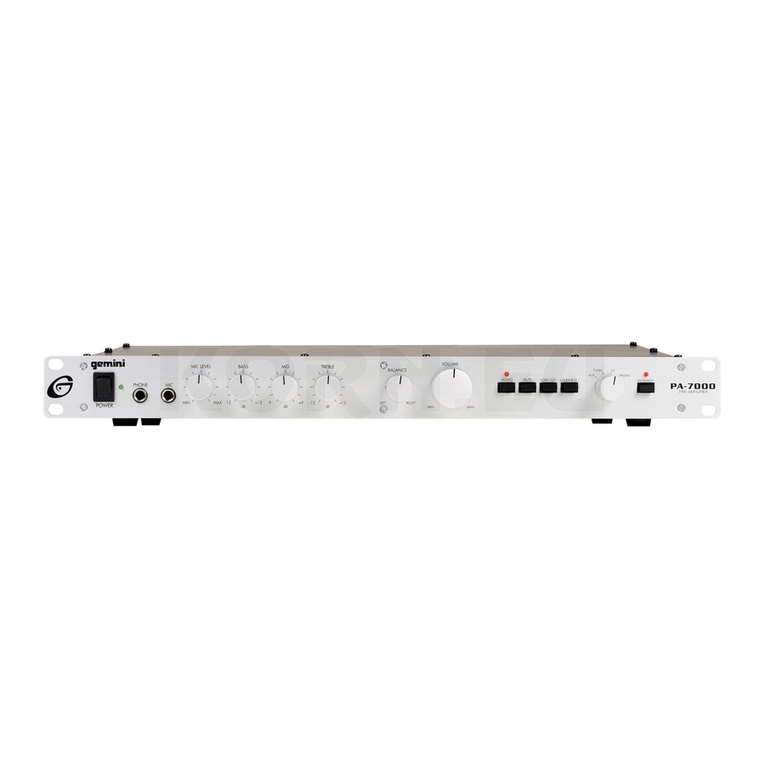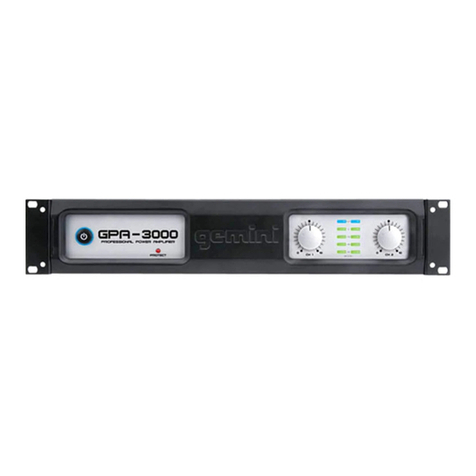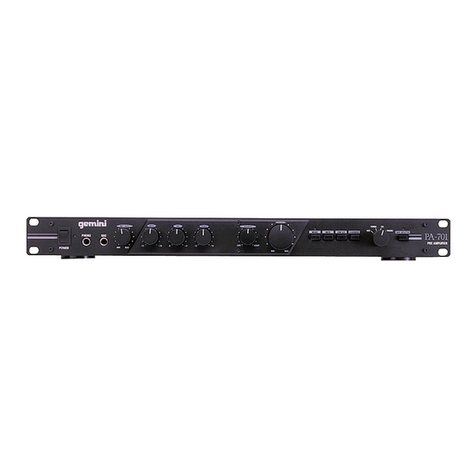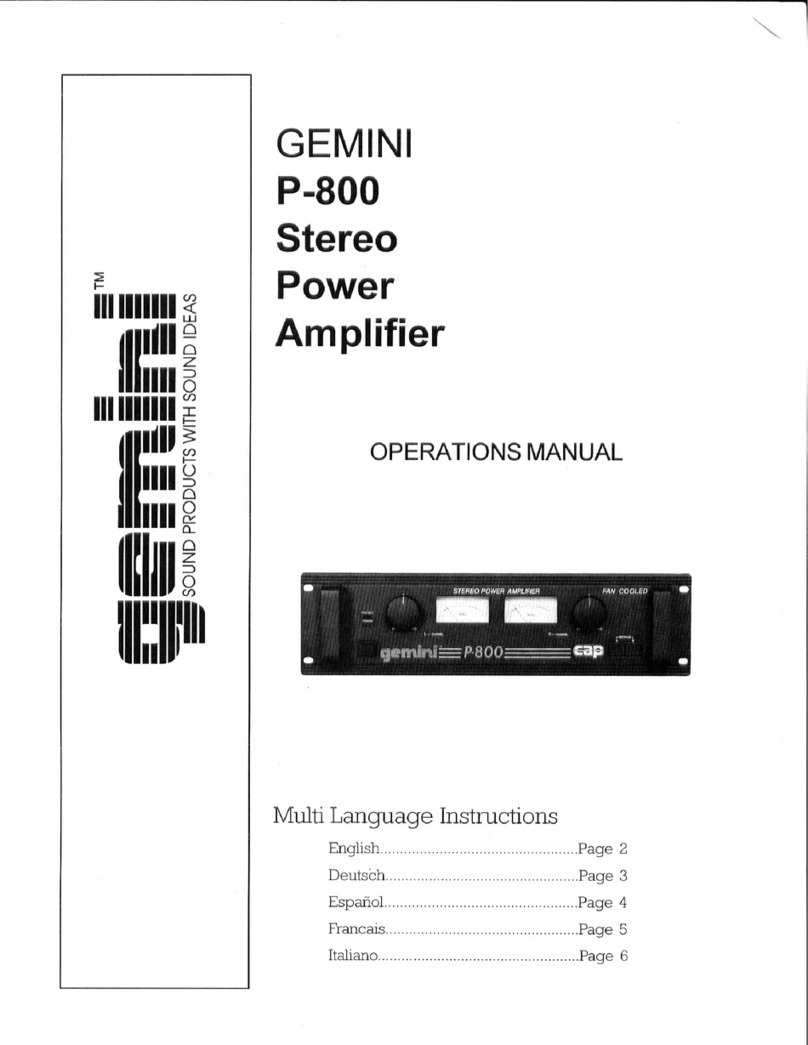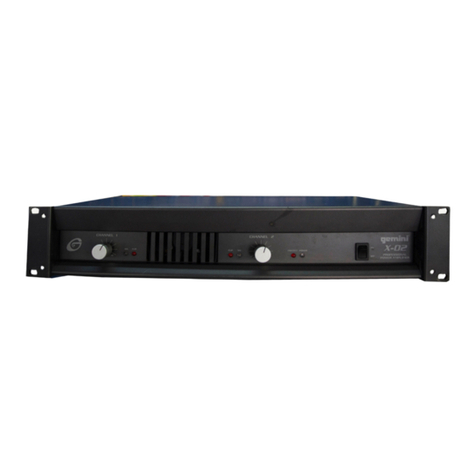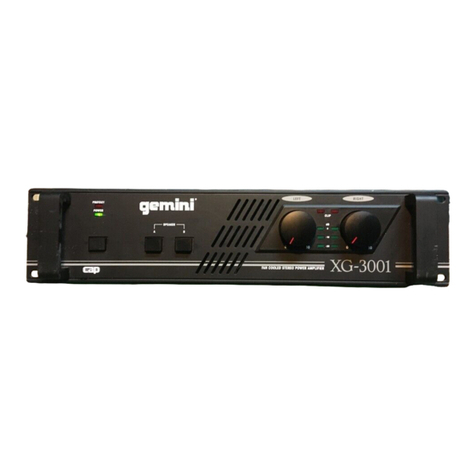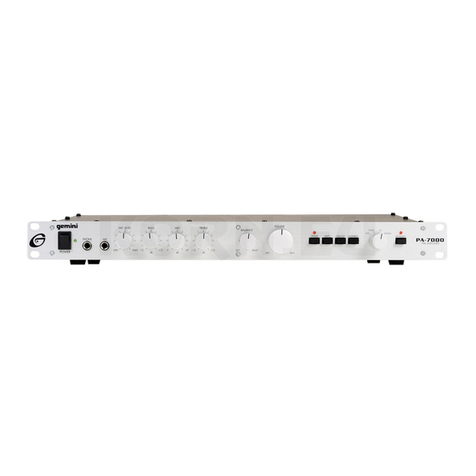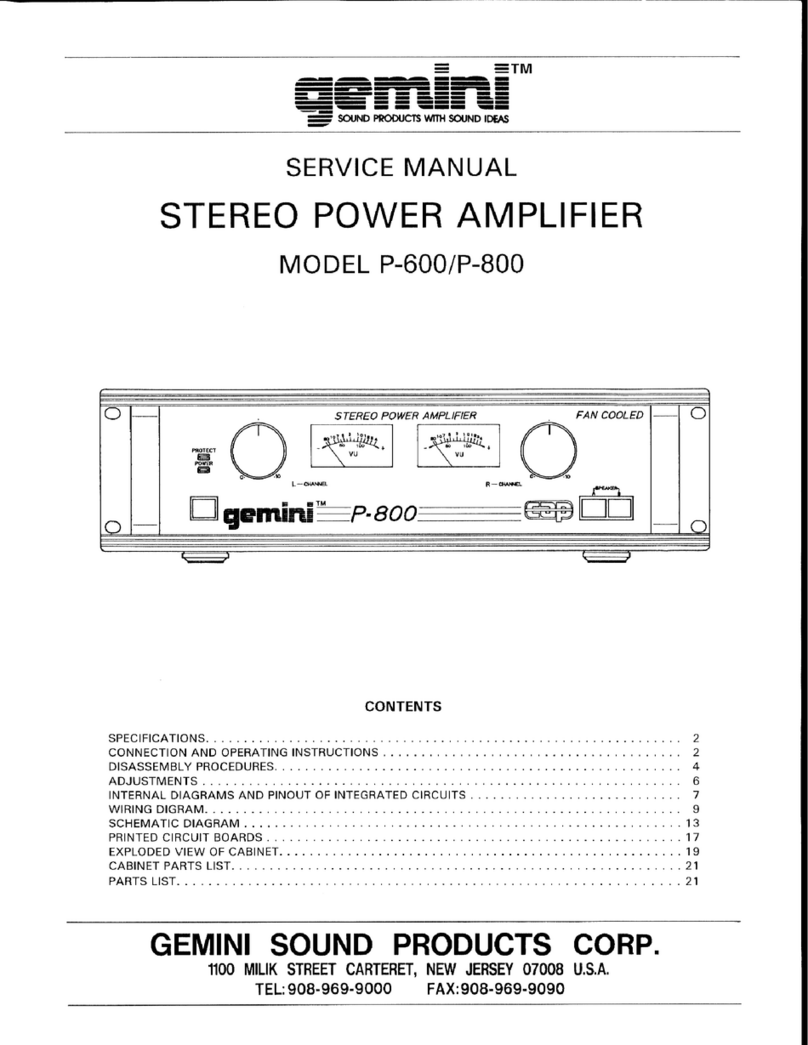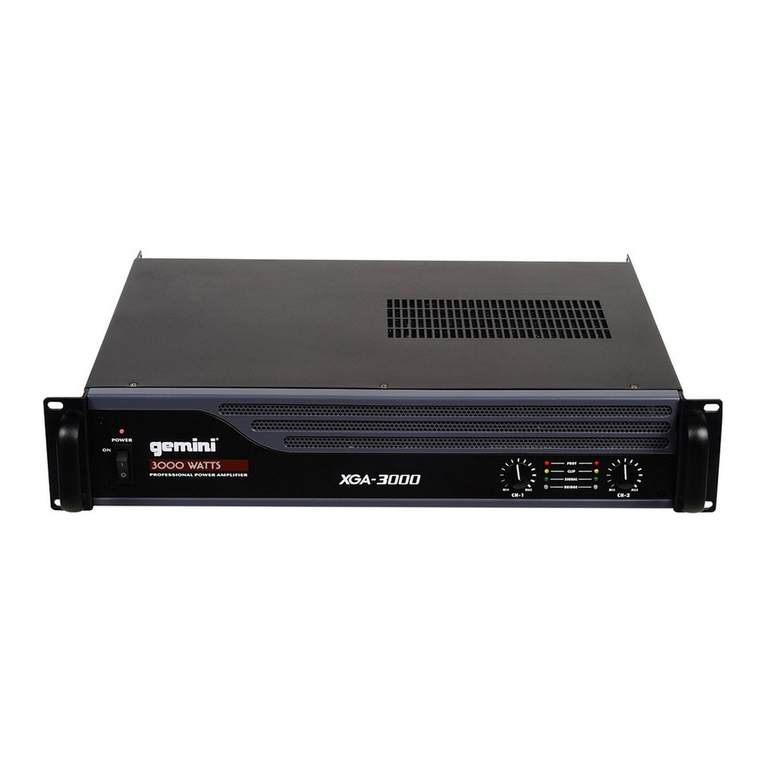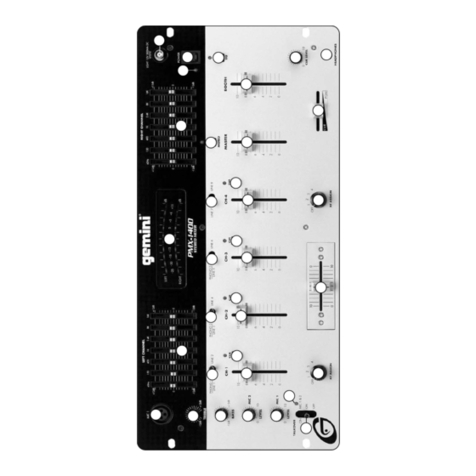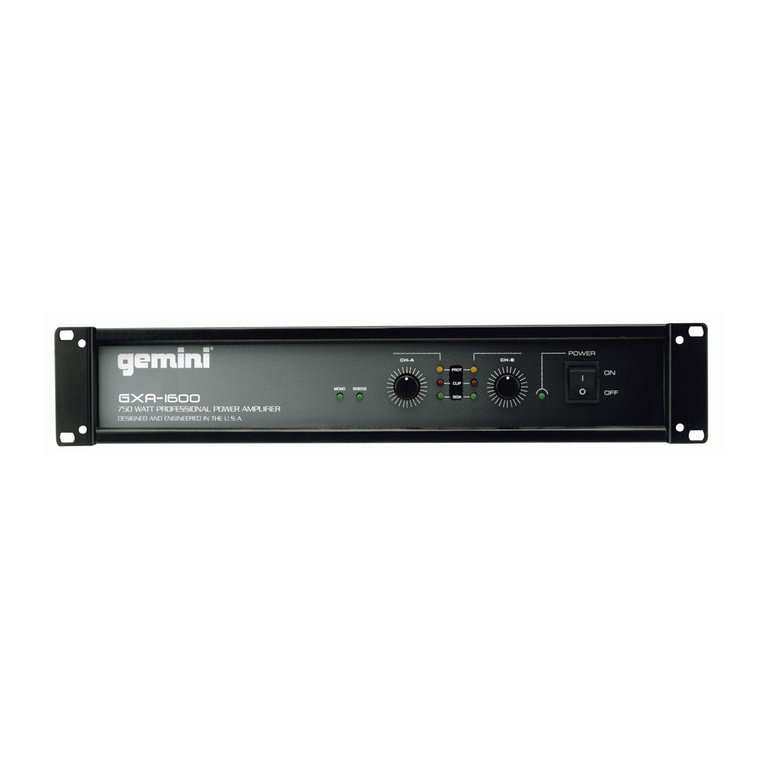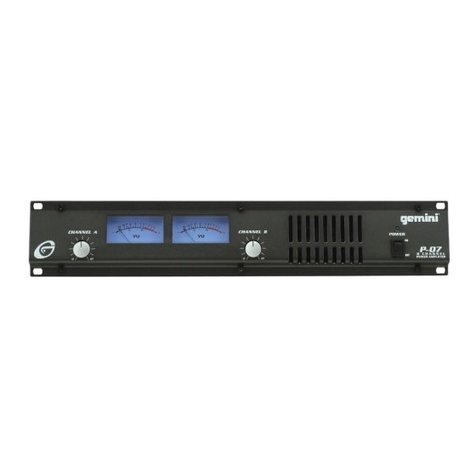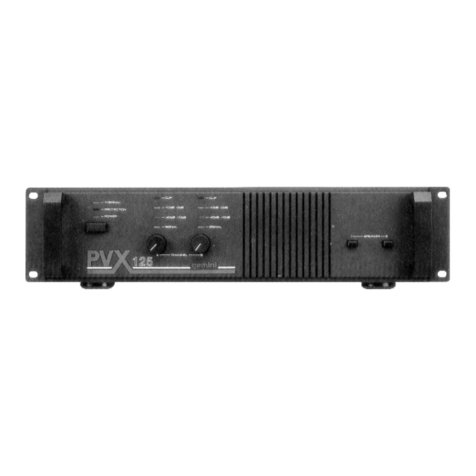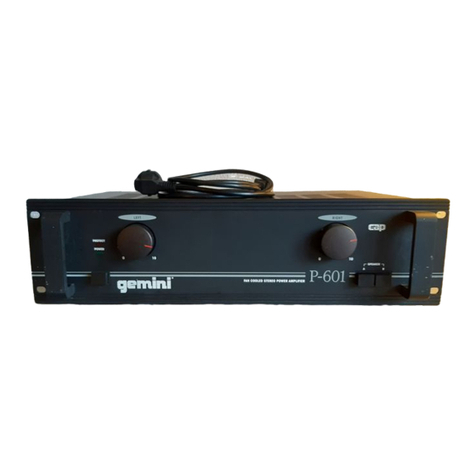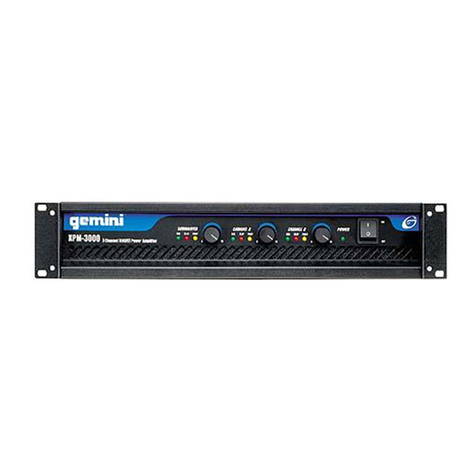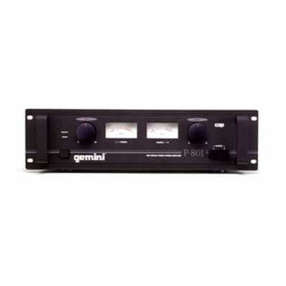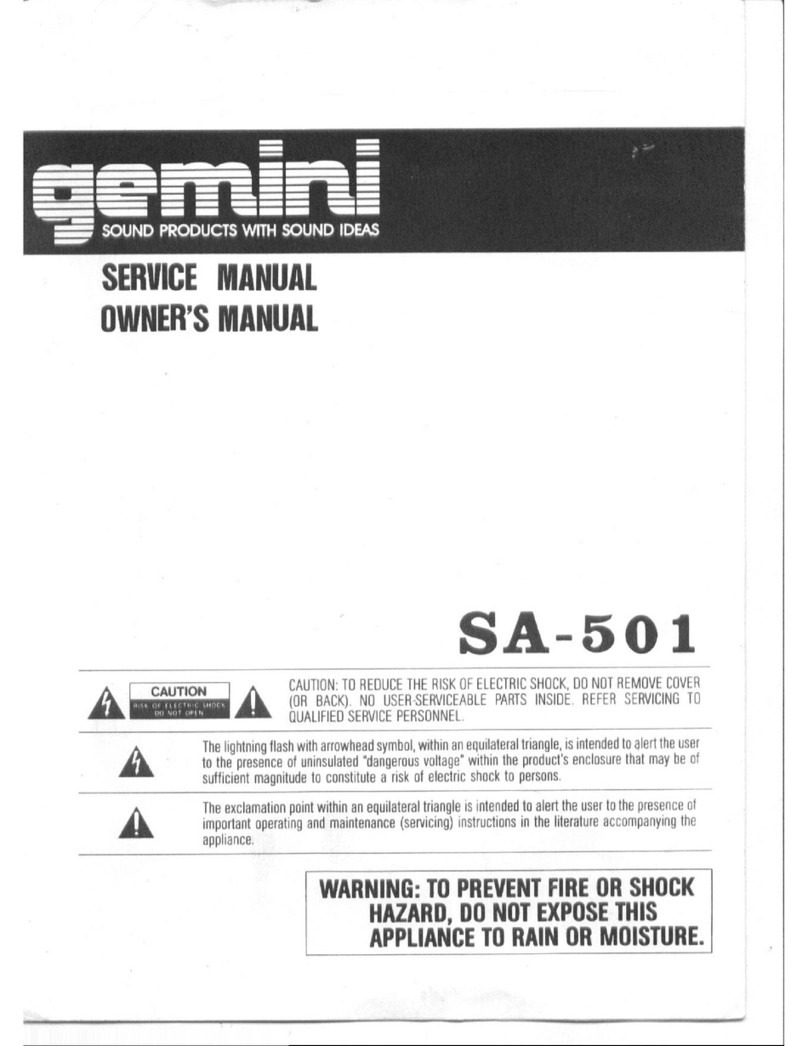
Page6
6. INTENSITÉ DU SON:L’intensité du son en général est commandée par la
commande VOLUME (6).
7. ÉQUILIBRE:Servez-vous de cette commande pour régler les niveaux relatifs
descanauxgaucheetdroit.Unedétentedelapositionde12heurescorrespond
au point d’équilibre (7).
8. AIGÜES: La commande AIGÜES - TREBLE (8) règle le niveau relatif des
fréquences élevées présentes dans le son.
9. MID:LacommandeMID(9)règleleniveaurelatifdesfréquencesintermédiaires
présentes dans le son.
10. BASSES:La commande BASSES (10) règle le niveau relatif des basses
fréquences présentes dans le son.
11. JACK PHONE:Jack d’entrée pour écouteurs de 1/4" (6,35 mm).
12. MONO:Lorsque la touche MONO (12) est activée (DEL allumée), les deux
canauxstéréosontmélangéspourproduireunsonmonophonique.Cemélange
minimise le ronronnement présent dans les anciens disques monophoniques.
Appuyez une seconde fois sur la touche (DEL s’éteint) pour reprendre le mode
stéréo.
13. ATTÉNUATION - MUTE: Le fait d’appuyer sur la touche réduit le volume du
signaldesortiedel’amplificateurd’environ20dB.Lefaitd’appuyeruneseconde
fois sur la touche, enlève la fonction d’atténuation. L’ATTÉNUATION - MUTE
(13) n’a aucun effet sur le volume du microphone.
14. SUPPRESSION DES BASSES FRÉQUENCES - LOW CUT:La sortie d’une
tabletournante contient en général des impulsions fortes mais inaudibles àdes
fréquences infrasoniques (en-dessous de 20 Hz) causées par le
gauchissement des disques, par la résonance aiguille/bras de lecture, et par
les vibrations qui atteignent la table tournante. Si elles sont amplifiées à pleine
puissance,ellespeuventgaspillerdelapuissancedel’amplificateuretdétériorer
laqualitéduson.LefiltredeSUPPRESSIONDESBASSESFRÉQUENCES(14)
atténue ces signaux indésirés.
15. INTENSITÉ DU SON:Lorsque pressée, la touche INTENSITÉ DU SON -
LOUDNESS (15) active un circuit de “compensation de l’intensité du son”
lequel, à un volume faible à moyen, amplifie la réponse des basses et des
aigües.
EMPLOIDEL’INTERRUPTEURDESOULÈVEMENTDE
LATERRE/MASSE
Selon la configuration du système, parfois la mise en place d’une terre/masse
produira une voie de signalisation moins bruyante. Parfois, le soulèvement de la
terre/masse peut éliminer des circuits de terre ou le ronronnement pour créer une
voie de signalisation moins bruyante.
1. L’appareil étant sous tension, écoutez le système dans le mode de repos
(sans présence de signal) tout en ayant la terre/masse en place (le GROUND
LIFT SWITCH (25) occupe la position de gauche).
2. Ensuite, mettez l’appareil hors tension avant de mouvoir le GROUND
LIFT SWITCH (25). Séparez la terre/masse en déplaçant le GROUND LIFT
SWITCH à droite, mettez l’appareil de nouveau sous tension et écoutez pour
déterminer quelle position fournira un signal sans bruit de fond et sans
ronronnement. Gardez le GROUND LIFT SWITCH dans la position de terre/
masse si le niveau de bruit reste le même dans l’une ou l’autre position.
ATTENTION: NE TERMINEZ EN AUCUN CAS LA TERRE C.A. SUR L’APPAREIL.
TERMINER LA TERRE C.A. PEUT ETRE DANGEREUX.
SENSIBILITÉ/IMPÉDANCE
DESENTRÉES
Micro................................1 mV/ 3 kohm
Phono.......................... ....3 mV/47 kohm
Bande, syntonisateur, CD,
auxiliaires......................150 mV/22 kohm
SORTIES/IMPÉDANCE
Enreg. bande...........................150 mV/ 3
kohm
Pré-sortie...............................max 11 V/1
kohm
DÉFORMATIONTOTALEDES
HARMONIQUES
Micro.............................moins de 0,02%
Phono............................moins de 0,04%
Bande, syntonisateur, CD,
auxiliaires........................moins de 0,01%
RAPPORT SIGNAL/BRUIT
Micro................................plus de 70 dB
Phono..............................plus de 90 dB
Bande, syntonisateur, CD,
auxiliaires........................plus de 100 dB
GÉNÉRALITÉS
Réponse de fréquence........5 Hz-30kHz
+0,-3dB
Basses.......................+/-12 dB à 100 Hz
Plage moyenne...............+/-9 dB à 1 kHz
Aigües........................+/-12 dB à 10 kHz
Intensité du son...........+9/0/9 dB à 100/1
K/10 kHz
Atténuation...................................-20dB
Puissance d’alimentation...........120 V ou
230 V, 50/60 Hz
Consommation d’énergie................15 W
Dimensions....483mm x 45mm x 248 mm
Poids..............................................4kg
INTRODUCTION
Nos félicitations à l’occasion de votre achat du préamplificateur Gemini PA-702
montable sur châssis à baies. Cet appareil très moderne inclut les caractéristiques
technologiques les plus récentes et il est couvert par une garantie de trois ans.
Avant de l’employer, lisez attentivement toutes les instructions ci-après.
AVERTISSEMENTS
1. On devrait lire toutes les consignes d’exploitation avant d’utiliser ce matériel.
2. Afin de réduire le risque de choc électrique, n’ouvrez pas l’appareil. Il n’y a pas
dePIÈCESREMPLAÇABLESÀL’INTÉRIEUR.Veuillezsoumettrel’entretien/la
réparation à un technicien dépanneur qualifié.
3. Ne pas exposer cet appareil aux rayons du soleil direct ou à une source de
chaleur telle qu’un radiateur ou un poêle.
4. Cet appareil devrait être nettoyé seulement avec un chiffon humide. Evitez les
solvants et autres détergents de nettoyage.
5. Quand on déplace ce matériel, il devrait être mis dans son carton et son
emballage d’origine. Ceci réduira le risque de dégâts pendant le transport.
6. NEPASEXPOSERCETAPPAREILÀLAPLUIEOUÀL’HUMIDITÉ.
7. N’UTILISEZPASDEPRODUITDENETTOYAGEAVECVAPORISATEUROU
LUBRIFIANTSURAUCUNSDESBOUTONSOUDESINTERRUPTEURS.
CONNEXIONS
1. Assurez-vous que l’interrupteur de PUISSANCE - POWER (1) occupe la
positionHORS TENSION - OFF.Tous les branchements doivent être effectués
avectous lesappareils HORSTENSION -OFF.
2. Pourobtenirlameilleurequalitédeson,n’utilisez quedes câblesRCA dehaute
qualité lorsque vous branchez les appareils au PA-701. Assurez-vous que
tous les câbles sont bien insérés.
3. Pour raccorder l’appareil PA-702 à votre amplificateur, branchez les jacks de la
LIGNEDESORTIE-OUTPUTLINE(22)duPA-702àvotre(vos)amplificateur(s).
4. Enfichez votre microphone dans le jack MICRO - MIC(5) sur le panneau avant
du PA-702.
5. Enfichez vos écouteurs dans le jack PHONO (11) sur le panneau avant.
6. Enfichez votre table tournante dans les jacks PHONO (16) et attachez le fil de
terre venant de la table tournante à la vis de TERRE - GND (23).
7. Enfichez votre appareil CD dans les jacks CD (17).
8. Enfichez votre syntonisateur dans les jacks SYNTONISATEUR-TUNER (18).
9. Toutautreappareildesortieduniveaudelaligne(telqu’unmélangeur)peutêtre
branché aux jacks AUX (19).
10. Il vous faudra deux jeux de câbles RCA pour raccorder votre enregistreur à
bande à l’appareil PA-702. Utilisez un jeu de câbles RCA pour raccorder les
jacks de reproduction ou de sortie de l’enregistreur aux jacks JOUER - PLAY
(20) sur l’arrière de l’appareil PA-702. Utilisez l’autre jeu de câbles RCA pour
raccorder les jacks d’enregistrement ou d’entrée du l’appareil à bande dans les
jacksENREGISTREMENT-REC(21)duPA-702.
REMARQUE:REMARQUE:
REMARQUE:REMARQUE:
REMARQUE: N’importe quel appareil de ligne du niveau peut être raccordé
aux jacks JOUER - PLAJOUER - PLA
JOUER - PLAJOUER - PLA
JOUER - PLAY (20),Y (20),
Y (20),Y (20),
Y (20), puis, peut être accédé par l’intermédiaire de
la touche MONITEUR DE BMONITEUR DE B
MONITEUR DE BMONITEUR DE B
MONITEUR DE BANDE -ANDE -
ANDE -ANDE -
ANDE - TT
TT
TAPE MONITAPE MONIT
APE MONITAPE MONIT
APE MONITOR (3)OR (3)
OR (3)OR (3)
OR (3).
FONCTIONNEMENT
1. PUISSANCE - POWER: Après avoir réalisé les branchements électriques à
l’appareil PA-702, et après voir vérifié que le SÉLECTEUR DE TENSION -
VOLTAGE SELECTOR (24) occupe la position correcte, raccordez le cordon
électrique à une source de puissance et appuyez sur la touche PUISSANCE
- POWER (1).(La DELs’allume).
2. CHOIX D’ENTRÉE:Le SÉLECTEUR D’ENTRÉE (2) détermine la source
d’entrée qui traversera l’appareil PA-702 vers l’amplificateur. Si la position
PHONOestchoisiesurleSÉLECTEURD’ENTRÉE(2),lasourceraccordéeau
jack PHONO (16) sur le panneau arrière sera choisie. Si la position CD est
choisie, la source raccordée au jack CD (17) sur l’arrière sera choisie.
3. MONITEUR DE BANDE:Lorsque vous appuyez sur la touche MONITEUR
DE BANDE (3) (DEL allumée), vous entendrez le signal de reproduction de
votre enregistreur à bande ou l’appareil vous avez branché aux jacks JOUER
- PLAY (20) sur le panneau arrière. Le fait d’appuyer sur la touche MONITEUR
DE BANDE (3) uneseconde fois (DEL éteinte),désactivele circuit du moniteur
de la bande.
4. NIVEAU MICRO:La commande NIVEAU MICRO - MIC LEVEL (4) règle le
volume du microphone.
5. JACK MICRO:Jack d’entrée du micro de 1/4" (6,35 mm) (5).
SPÉCIFICATIONS
